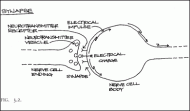Neurotransmitters
Although a number of circuits with different neurotransmitters connect to and run through the ventral tegmentum, the main tracts use dopamine. Other important tracts use serotonin, norepinephrine, or endorphin. Let’s look further at what neurotransmitters are and what they do.
Brain cells communicate messages via chemicals in the brain that are called neurotransmitters. Neurotransmitters are compounds that are secreted at the end of a nerve cell when it is electrically stimulated by another cell attached to it. They are secreted into a tiny gap between the cells, which is called a synapse (fig. 3.2). As they dissolve into the fiuid within the synapse, some of these molecules become bound to receptors.
Receptors and neurotransmitters function in a lock-and-key fashion. The receptor is shaped precisely to fit the specific neurotransmitter it needs. Other chemicals will not bind at all, or might bind only loosely, producing a weaker signal.
Nerve cells generally produce only one kind of chemical.
This is what allows messages to flow in tracts, which are laid out in a fashion similar to an electrical circuit within the brain. One of the most common neurotransmitters involved in emotions and behaviors is called serotonin, or 5-hydroxytryptamine.
The suffix “ergic” is attached to the name of the specific neurotransmitter so as to identify which type of nerve cell it is. Nerve cells that produce serotonin are called serotoninergic and those that secrete dopamine are called dopaminergic neurons. The producers of norepinephrine (a substance similar to adrenaline) are called adrenergic, and the ones that produce peptides, such as endorphins and others, are called peptidergic.
 What starts out sounding like a fairly simple pattern - nerve cells communicating with each other in a specific chemical chain - is actually complicated. It might help to think of the brain as resembling an ecosystem. Years ago we thought of clinical depression as involving a lack either of serotonin or of norepinephrine, which leads to a chemical imbalance - kind of like tipping a seesaw.
What starts out sounding like a fairly simple pattern - nerve cells communicating with each other in a specific chemical chain - is actually complicated. It might help to think of the brain as resembling an ecosystem. Years ago we thought of clinical depression as involving a lack either of serotonin or of norepinephrine, which leads to a chemical imbalance - kind of like tipping a seesaw.
We know now that there are no fewer than fifteen different subtypes of serotonin receptors, some of which perform opposite functions, and the list is growing at the research labs. We also know that there are other chemicals involved in depression, perhaps farther “upstream” or “downstream,” and that the nature of how these circuits work with one another can be influenced by other factors. So it’s not a simple seesaw, after all.
Just as the loss of one species can change the environment of an entire forest or marsh, a change in the activity of just one neurotransmitter can have a cascade effect. As these tracts of nerve cells interact with each other, broad shifts occur within the chemical environment of the brain.
Stimulation of one area by a specific drug might have a direct effect, as well as a number of secondary effects resulting from changes that occur in the system as a whole. This is important to remember when we try to understand the wide variety of behavioral and emotional changes associated with the use of and addiction to mood-altering drugs.
Neurotransmitters are released by nerve cells when the cell membrane receives an electrical charge. The cell membrane is a porous sac composed of specialized fats and tiny protein complexes. Ionized salts such as sodium, potassium, chloride, or calcium line the inside and outside of this membrane, and produce an electrical charge, much like that of a battery.
Tiny channels that function like gates allow movement of these chemicals inside and outside of the cell, in response to interactions with chemicals, usually neurotransmitters. Once a neurotransmitter settles into its receptor, like a key fitting into a lock, these channels open and allow the ions to move.
This changes the membrane’s electrical charge, which moves in a wave-like fashion along the cell from the cell body to the axon, then to the nerve endings or synapses. Once this wave of electrical charge reaches the nerve ending at the synapse, a tiny packet of neurotransmitter is released into the synapse. This neurotransmitter then attaches to the body of the next cell in the chain, starting a chain reaction along the nerve tract.
The neurotransmitter in the synapse is deactivated in one of two ways. It is either taken back up into the nerve ending of the cell that released it - a process we call reuptake - or it is degraded by enzymes that are found in the synapse. If the neurotransmitter is not taken back up or degraded, the signal continues, as if someone were holding a finger down on a doorbell button.
Most of the drugs that are prescribed for psychiatric conditions such as depression or anxiety work indirectly, either by affecting the rate of reuptake of the neurotransmitter or by inhibiting its destruction by enzymes within the synapse. The nerve cell itself and the tract it belongs to continue functioning as they are supposed to, firing or shutting down appropriately, depending on the stimulus. On the other hand, mood-altering drugs - those with the potential to be addictive - often override this system by tricking the nerve cell into thinking it is being stimulated by a natural neurotransmitter.
Elizabeth Connell Henderson, M.D.
Glossary
Appendix A: Regulation of Addictive Substances
Appendix B: Sources of Additional Information